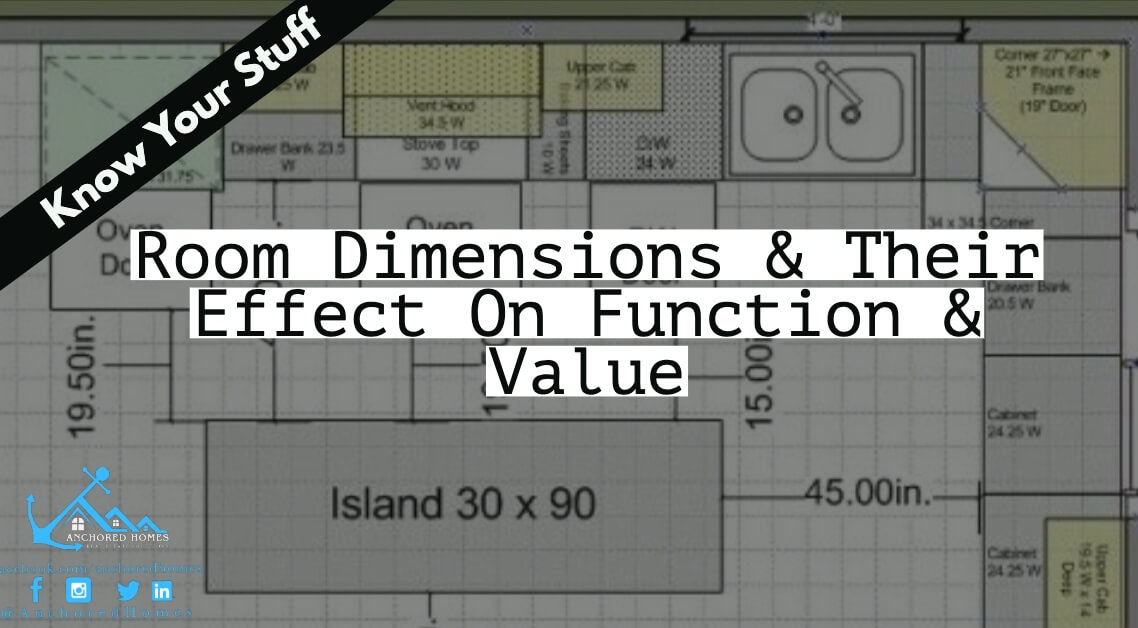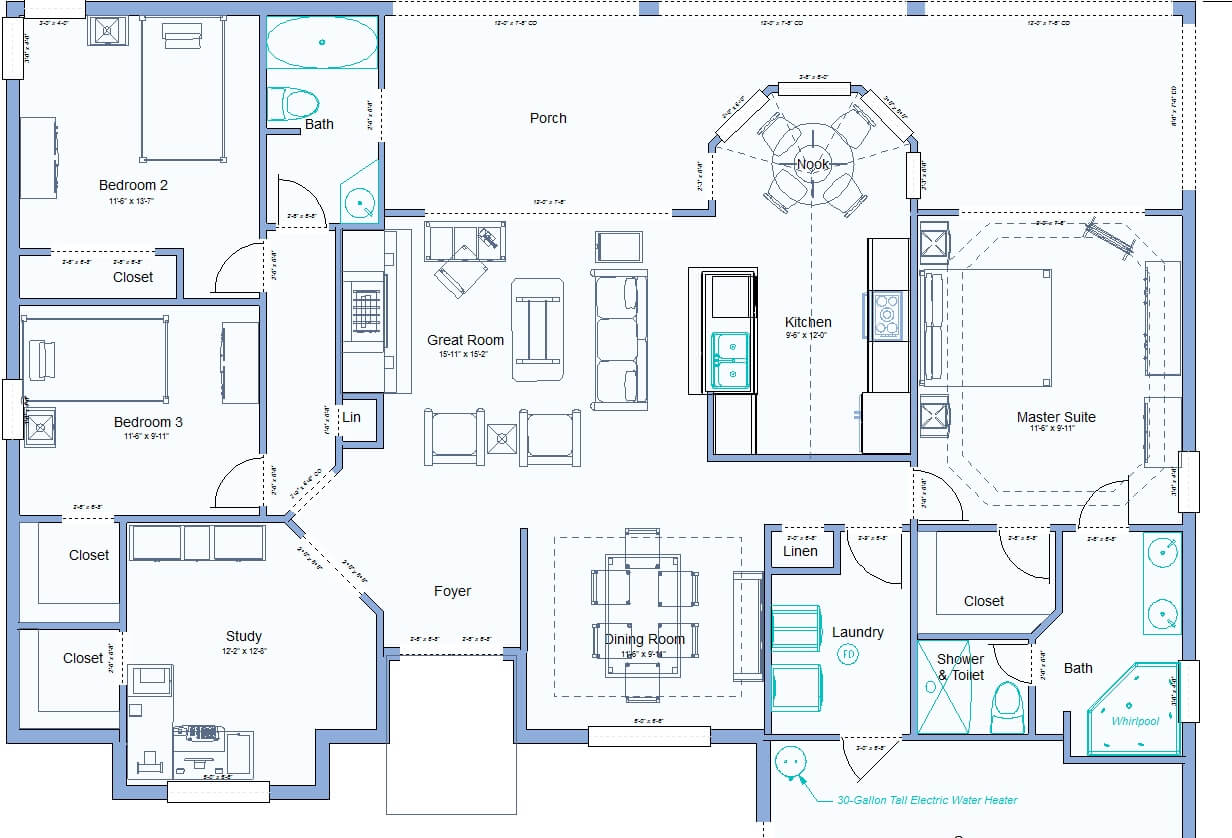
Design Walkthroughs – Common Room Sizes and Square Footage


Based on the 2015 U.S. Census, the median size of newly-built homes in America is nearly 2,500 square feet. And oddly enough, there’s only room that builders report including in a house 100 percent of the time: the master bedroom.
But what about the kitchen or a living room? Surely these are built in each new house?
They are – but more often they are included in a ‘great room’, a space and growing trend in American houses that can include any number of traditional rooms combined into one, such as living or family rooms, dining rooms, kitchens, and even pantry or laundry rooms.
Whether you love great rooms and open-concept style living or you prefer more defined rooms with traditional functions, this article is exploring common room sizes for American homes. Use this information when designing with Punch! Software to build or create a new home, or restructure your lifestyle in your current home.
Living Room
In a traditional home, a living room or family room often functions as a main area for the family to gather when people aren’t cooking, eating, or sleeping. The size of the room will typically dictate what functions will take place there: is it simply a TV-watching room or is there space for a second conversational area or for the kids to play on the floor?
Here are some common sizes for the living room:
| Size / square footage | Function(s) | Seating area | |
| Tiny | 7 ft x 10 ft(70 square feet) | Relaxing quietly | A small loveseat can fit no more than 2 people |
| Small | 10 ft x 13 ft(130 square feet) | Mounting a TV on the wall for entertainment | A small loveseat and 1-2 chairs comfortable fits 4 people |
| Medium | 12 ft x 18 ft(216 square feet) | Increasing the conversational area; TV doesn’t have to be wall-mounted to save space | A larger couch, or two smaller loveseats, along with 2-3 chairs offers seating for several people |
| Large | 15 ft x 20+ ft(300 square feet) | Creating a quieter area away from the TV, accommodating two separate conversation areas | Any combination of 1-2 couches and several chairs provides seating for 10+ people |
Kitchen
Kitchens are often considered the heart of the home – a lot of family activities take place here, from meal prep, dinner, snack time, and even homework sessions. But an older home’s architecture may feel more like it was meant for one cook only (as we explored in <this kitchen triangle blog>).
This space is very different from any other space in the house. A kitchen can be as small as a couple cabinets and countertops with a sink and a cooktop, or it can be hundreds of square feet in size. It is one of the most designed areas in the home – instead of a simple blank slate of four walls, the kitchen typically includes a lot of built-ins, like counters and cupboards, islands, cut-outs for refrigerator and oven, and dining areas like nooks or bars.
These are minimum sizes for components of kitchens, which can be worked into any kitchen design, including the kitchen triangle or a common galley-style kitchen:
| Purpose | Location | Size |
| Storage | Refrigerator and dry-goods storage should be located adjacent to each other and to a countertop. Locating this area as close to an entry point is helpful in unloading groceries. | Countertop: 15-24 inches in length Upper cabinets: typically situated 18 inches above the counter; often 30-42 inches in height, though don’t set them higher than 7 feet to avoid use of a step ladder. Lower cabinets: typically 36 inches high and 24 inches deep. |
| Preparation | Typically located around the sink. Including the dishwasher and trash bin here is efficient. | Countertop: minimum 36 inches of uncluttered countertop space, on one or both sides of the sink. |
| Cooking | Arrange the cooking around the range and wall ovens; including small appliances like toasters, coffee makers, and blenders here will also help leave your preparation area clear. | Countertop: allow 21-36 inches around the cooktop. |
| Maneuvering | Cabinets should all be able to open without block access to other cabinets. | Entry points: as small as 36 inches with only a cabinet on one side, but bump to at least 42 inches when two cabinets face each other. |
Dining Rooms
Dining rooms sizes can be a matter of preference – do you prefer dine-in kitchens or a separate space to eat that can allow for some formality and even a workspace for kids or adults?
Here are common sizes for proper dining rooms, allowing at least one doorway. If you don’t need door clearance, you can go a little smaller with the room sizes while still maintaining enough space for each guest. We also included a dining nook size, in case this space is incorporated into a larger ‘great room’ in your home.
| Size / square footage | Seating area | Considerations | |
| Dining nook | 5 ft x 6 ft(30 square feet) | Seats 4 or 6 | Try using a bench or banquette along one wall of your nook for more seating area |
| Small dining room | 11 ft x 11 ft(121 square feet) | Seats 4 comfortably, while providing enough door clearance | Remove a side board or buffet and opt instead for circular tables in the corners. |
| Medium dining room | 11 ft x 14 ft(154 square feet) | Seats 6 comfortably, with room for a dining table leaf to comfortable seat 8 guests | Stick to only one side board or buffet, or opt for built-in shelving. |
| Large dining room | 12 ft x 16 ft(192 square feet) | Easily seats 8 guests, and up to 12 depending on the room’s layout | If you only need space for 8 guests, you can add in more architectural interest with larger doors or a fireplace. |
Bedrooms
The rooms where we sleep can be as simple or multi-functioning as you desire. Some homeowners like a one-trick-pony approach: they need the bedroom to function only as a place to catch some Z’s. But others need their bedrooms to do double-duty, with extra space for an office set-up, a conversational or relaxation area, or play space for kids.
For the sake of simplicity, we are providing the smallest size room based on the size of the bed – but know that the more space you add, the more function you can add to your bedroom. And if you really a true master bedroom, you’ll want to at least double these sizes.
| Bed size | Minimum size / square footage |
| Twin bed | 7 ft x 7 ft(49 square feet) |
| 2 twin beds | 9 ft x 9 ft(81 square feet) |
| Double bed | 9 ft x 9ft 6in(85.5 square feet) |
| Queen bed | 9ft 6in ft x 10 ft(96 square feet) |
| King bed | 9ft 6in ft x 11ft 6in(109 square feet) |
Office
Use the above bedroom sizes as a starting point for an at-home office. Before designing a room too large, consider your needs: a small desk for your laptop, or a library and digital workspace that includes large bookshelves, storage, and an L-shaped desk to accommodate a lot of technology. Perhaps you even want to create a built-in workspace.
Once you have defined your needs, remember to include natural light and enough power sockets for all the equipment needed – plus access to Wi-Fi and hard-wired internet, if you need it.
Use these common sizes as a baseline for design. It’s likely that many rooms in your house won’t match these dimensions exactly, but by providing this approach to home design, we hope to make this process less overwhelming and more fun!
See Original Article Here:https://www.punchsoftware.com/blog/post/common-room-sizes







